Designing an Integrated Outdoor Play Area for Children
VerifiedAdded on 2022/11/28
|7
|1580
|301
Project
AI Summary
This project details the design of an integrated outdoor play area for children aged 3-6, emphasizing STEM education principles. The design incorporates various zones for different types of play, including active, sensory, creative, and social/reflective activities. The play area includes features such as a block play area, sandpit, abacus rails, art stations, a puppet stage, a general play area with swings and slides, a gardening patch, and a small water body. The rationale behind each feature is explained, highlighting how they promote physical, cognitive, and social-emotional development. The design adheres to principles of safety, accessibility, and integration, encouraging children to explore their imagination and develop a sense of responsibility. The project also includes a schematic representation of the play area and references relevant literature on play area design and child development.
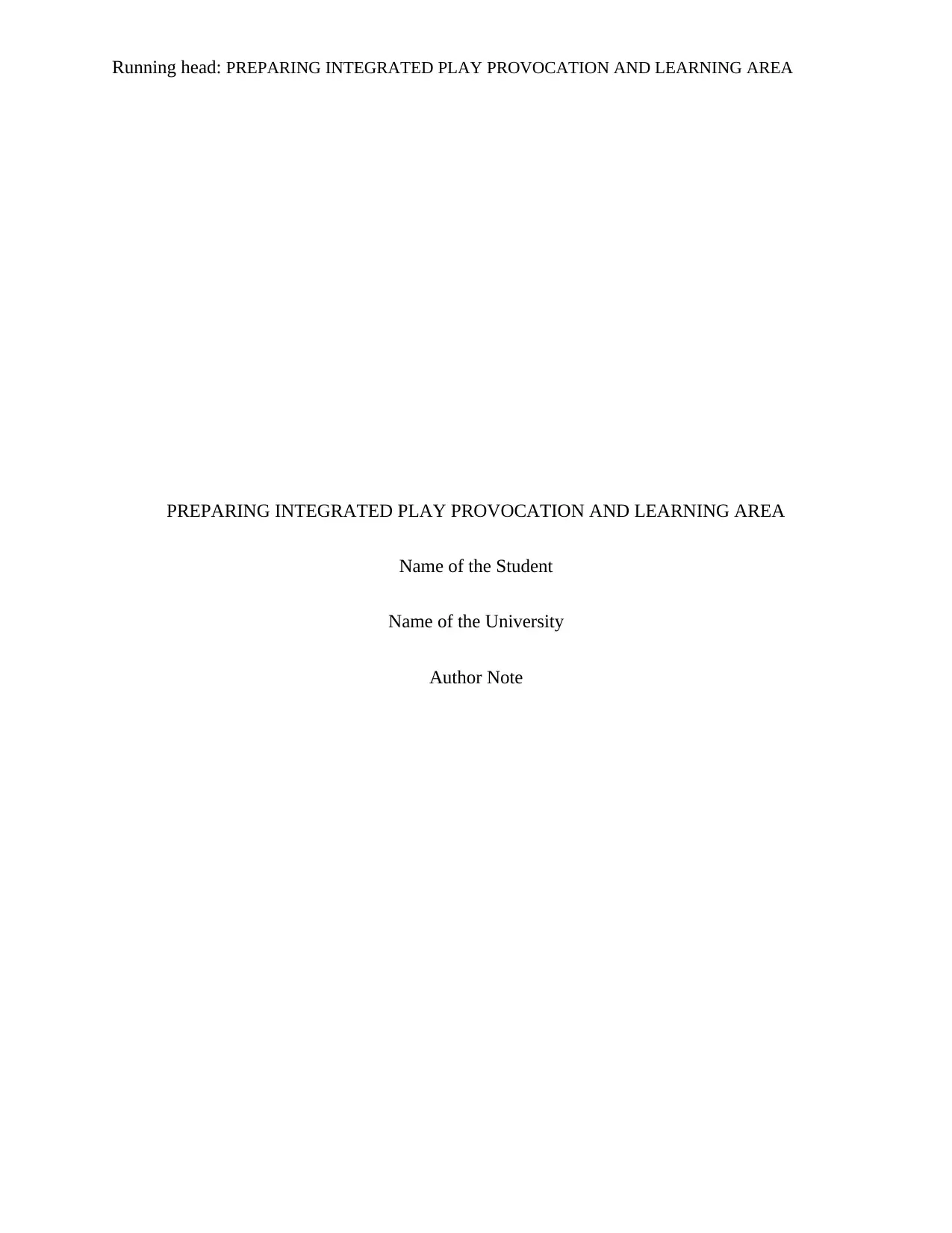
Running head: PREPARING INTEGRATED PLAY PROVOCATION AND LEARNING AREA
PREPARING INTEGRATED PLAY PROVOCATION AND LEARNING AREA
Name of the Student
Name of the University
Author Note
PREPARING INTEGRATED PLAY PROVOCATION AND LEARNING AREA
Name of the Student
Name of the University
Author Note
Paraphrase This Document
Need a fresh take? Get an instant paraphrase of this document with our AI Paraphraser
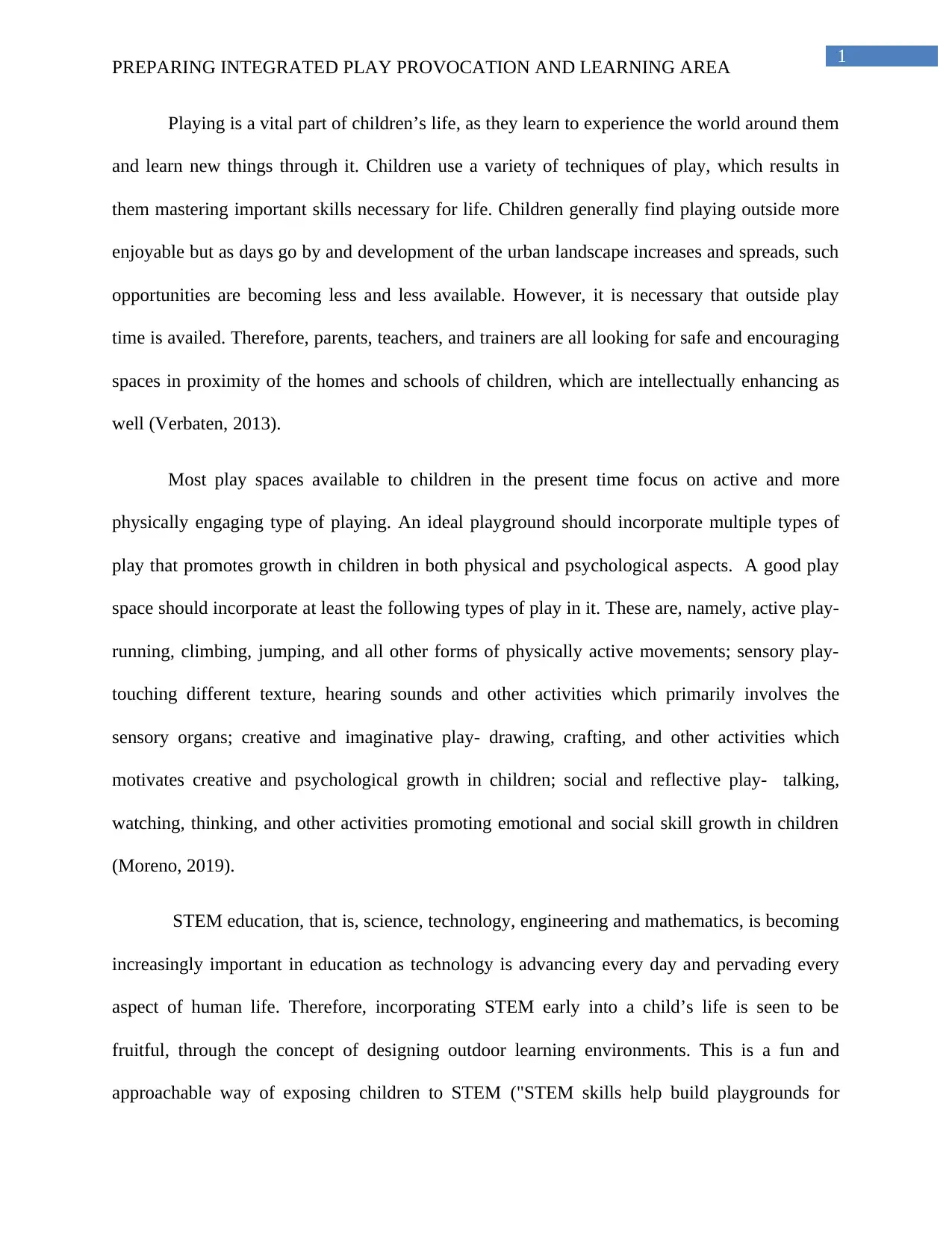
1
PREPARING INTEGRATED PLAY PROVOCATION AND LEARNING AREA
Playing is a vital part of children’s life, as they learn to experience the world around them
and learn new things through it. Children use a variety of techniques of play, which results in
them mastering important skills necessary for life. Children generally find playing outside more
enjoyable but as days go by and development of the urban landscape increases and spreads, such
opportunities are becoming less and less available. However, it is necessary that outside play
time is availed. Therefore, parents, teachers, and trainers are all looking for safe and encouraging
spaces in proximity of the homes and schools of children, which are intellectually enhancing as
well (Verbaten, 2013).
Most play spaces available to children in the present time focus on active and more
physically engaging type of playing. An ideal playground should incorporate multiple types of
play that promotes growth in children in both physical and psychological aspects. A good play
space should incorporate at least the following types of play in it. These are, namely, active play-
running, climbing, jumping, and all other forms of physically active movements; sensory play-
touching different texture, hearing sounds and other activities which primarily involves the
sensory organs; creative and imaginative play- drawing, crafting, and other activities which
motivates creative and psychological growth in children; social and reflective play- talking,
watching, thinking, and other activities promoting emotional and social skill growth in children
(Moreno, 2019).
STEM education, that is, science, technology, engineering and mathematics, is becoming
increasingly important in education as technology is advancing every day and pervading every
aspect of human life. Therefore, incorporating STEM early into a child’s life is seen to be
fruitful, through the concept of designing outdoor learning environments. This is a fun and
approachable way of exposing children to STEM ("STEM skills help build playgrounds for
PREPARING INTEGRATED PLAY PROVOCATION AND LEARNING AREA
Playing is a vital part of children’s life, as they learn to experience the world around them
and learn new things through it. Children use a variety of techniques of play, which results in
them mastering important skills necessary for life. Children generally find playing outside more
enjoyable but as days go by and development of the urban landscape increases and spreads, such
opportunities are becoming less and less available. However, it is necessary that outside play
time is availed. Therefore, parents, teachers, and trainers are all looking for safe and encouraging
spaces in proximity of the homes and schools of children, which are intellectually enhancing as
well (Verbaten, 2013).
Most play spaces available to children in the present time focus on active and more
physically engaging type of playing. An ideal playground should incorporate multiple types of
play that promotes growth in children in both physical and psychological aspects. A good play
space should incorporate at least the following types of play in it. These are, namely, active play-
running, climbing, jumping, and all other forms of physically active movements; sensory play-
touching different texture, hearing sounds and other activities which primarily involves the
sensory organs; creative and imaginative play- drawing, crafting, and other activities which
motivates creative and psychological growth in children; social and reflective play- talking,
watching, thinking, and other activities promoting emotional and social skill growth in children
(Moreno, 2019).
STEM education, that is, science, technology, engineering and mathematics, is becoming
increasingly important in education as technology is advancing every day and pervading every
aspect of human life. Therefore, incorporating STEM early into a child’s life is seen to be
fruitful, through the concept of designing outdoor learning environments. This is a fun and
approachable way of exposing children to STEM ("STEM skills help build playgrounds for
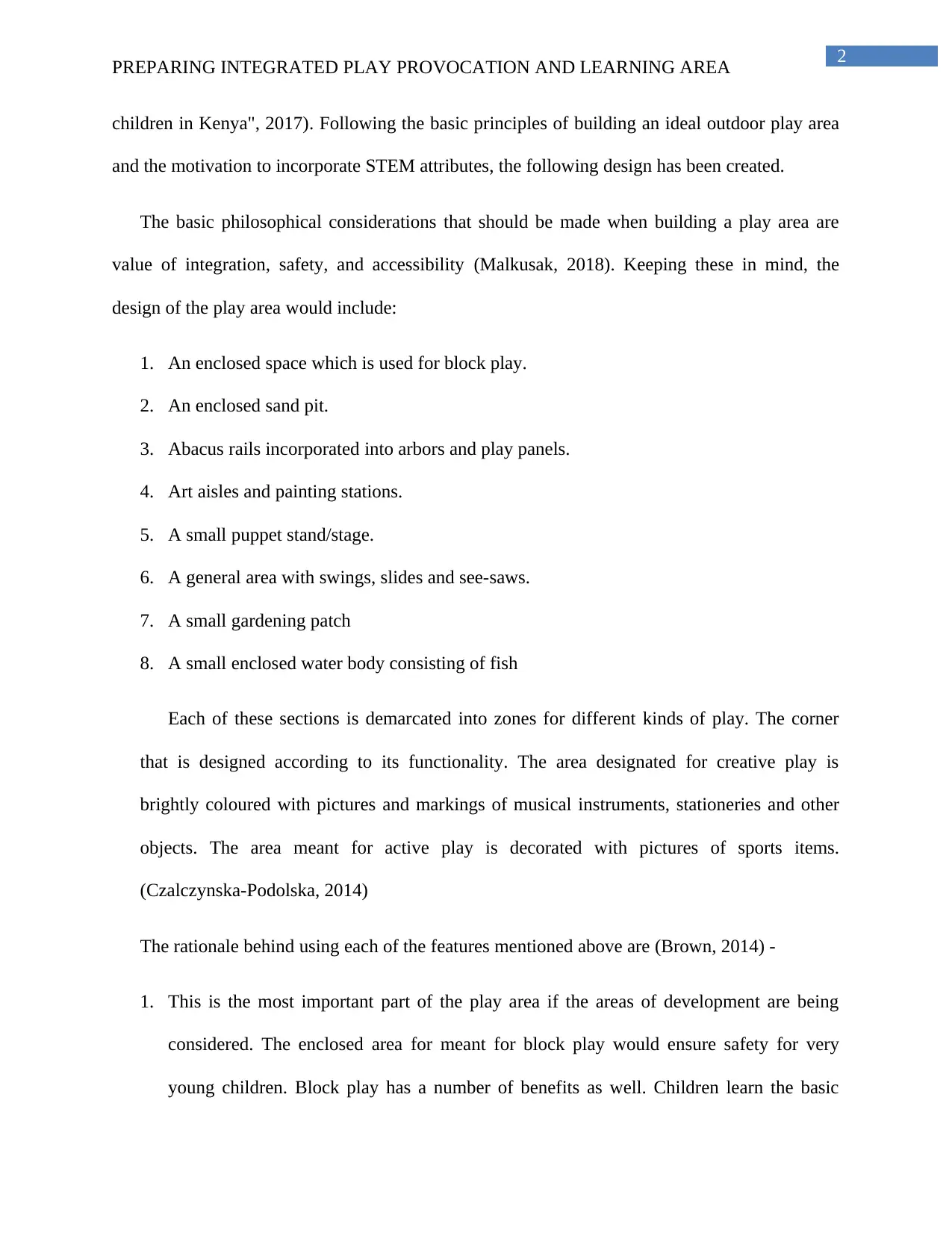
2
PREPARING INTEGRATED PLAY PROVOCATION AND LEARNING AREA
children in Kenya", 2017). Following the basic principles of building an ideal outdoor play area
and the motivation to incorporate STEM attributes, the following design has been created.
The basic philosophical considerations that should be made when building a play area are
value of integration, safety, and accessibility (Malkusak, 2018). Keeping these in mind, the
design of the play area would include:
1. An enclosed space which is used for block play.
2. An enclosed sand pit.
3. Abacus rails incorporated into arbors and play panels.
4. Art aisles and painting stations.
5. A small puppet stand/stage.
6. A general area with swings, slides and see-saws.
7. A small gardening patch
8. A small enclosed water body consisting of fish
Each of these sections is demarcated into zones for different kinds of play. The corner
that is designed according to its functionality. The area designated for creative play is
brightly coloured with pictures and markings of musical instruments, stationeries and other
objects. The area meant for active play is decorated with pictures of sports items.
(Czalczynska-Podolska, 2014)
The rationale behind using each of the features mentioned above are (Brown, 2014) -
1. This is the most important part of the play area if the areas of development are being
considered. The enclosed area for meant for block play would ensure safety for very
young children. Block play has a number of benefits as well. Children learn the basic
PREPARING INTEGRATED PLAY PROVOCATION AND LEARNING AREA
children in Kenya", 2017). Following the basic principles of building an ideal outdoor play area
and the motivation to incorporate STEM attributes, the following design has been created.
The basic philosophical considerations that should be made when building a play area are
value of integration, safety, and accessibility (Malkusak, 2018). Keeping these in mind, the
design of the play area would include:
1. An enclosed space which is used for block play.
2. An enclosed sand pit.
3. Abacus rails incorporated into arbors and play panels.
4. Art aisles and painting stations.
5. A small puppet stand/stage.
6. A general area with swings, slides and see-saws.
7. A small gardening patch
8. A small enclosed water body consisting of fish
Each of these sections is demarcated into zones for different kinds of play. The corner
that is designed according to its functionality. The area designated for creative play is
brightly coloured with pictures and markings of musical instruments, stationeries and other
objects. The area meant for active play is decorated with pictures of sports items.
(Czalczynska-Podolska, 2014)
The rationale behind using each of the features mentioned above are (Brown, 2014) -
1. This is the most important part of the play area if the areas of development are being
considered. The enclosed area for meant for block play would ensure safety for very
young children. Block play has a number of benefits as well. Children learn the basic
⊘ This is a preview!⊘
Do you want full access?
Subscribe today to unlock all pages.

Trusted by 1+ million students worldwide
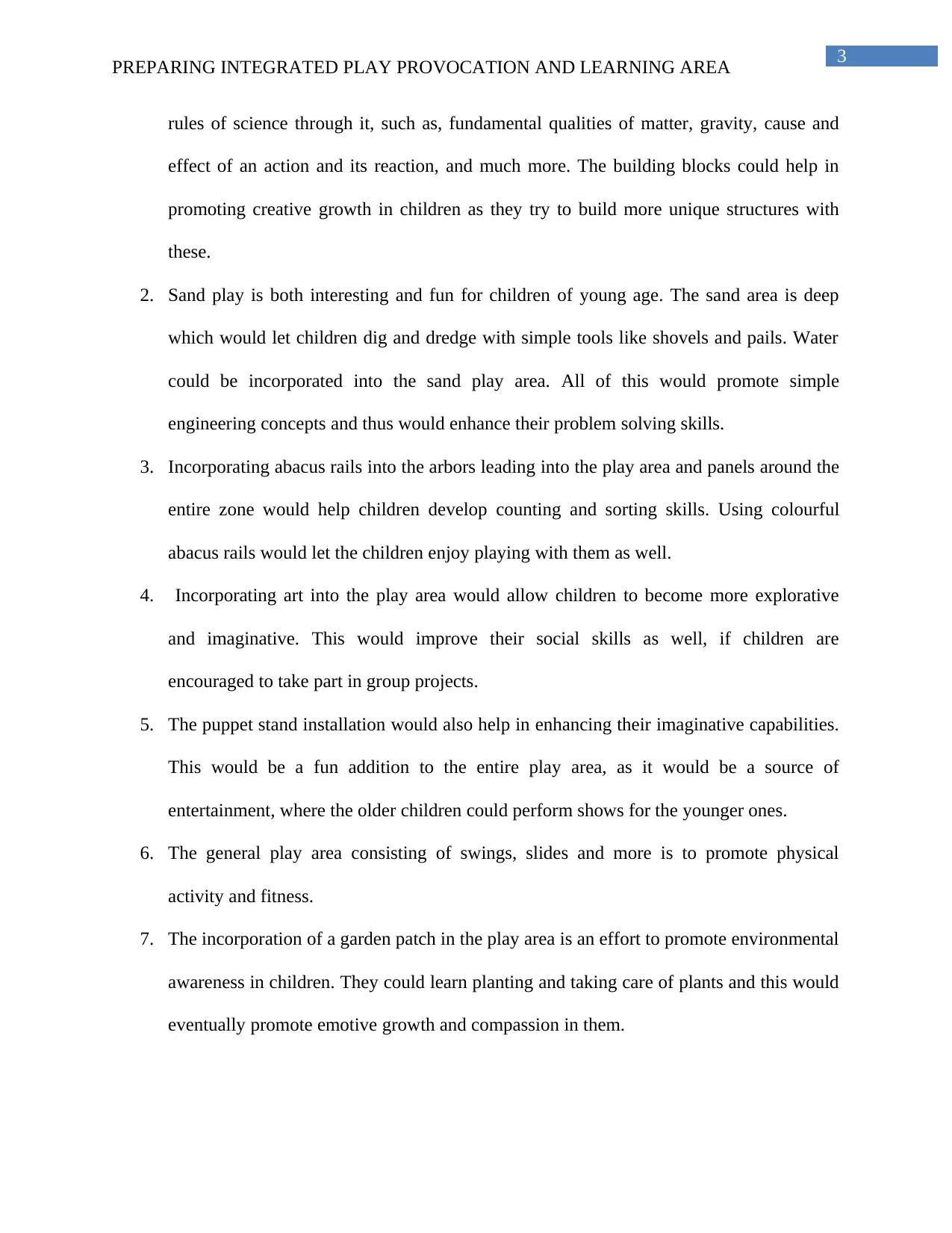
3
PREPARING INTEGRATED PLAY PROVOCATION AND LEARNING AREA
rules of science through it, such as, fundamental qualities of matter, gravity, cause and
effect of an action and its reaction, and much more. The building blocks could help in
promoting creative growth in children as they try to build more unique structures with
these.
2. Sand play is both interesting and fun for children of young age. The sand area is deep
which would let children dig and dredge with simple tools like shovels and pails. Water
could be incorporated into the sand play area. All of this would promote simple
engineering concepts and thus would enhance their problem solving skills.
3. Incorporating abacus rails into the arbors leading into the play area and panels around the
entire zone would help children develop counting and sorting skills. Using colourful
abacus rails would let the children enjoy playing with them as well.
4. Incorporating art into the play area would allow children to become more explorative
and imaginative. This would improve their social skills as well, if children are
encouraged to take part in group projects.
5. The puppet stand installation would also help in enhancing their imaginative capabilities.
This would be a fun addition to the entire play area, as it would be a source of
entertainment, where the older children could perform shows for the younger ones.
6. The general play area consisting of swings, slides and more is to promote physical
activity and fitness.
7. The incorporation of a garden patch in the play area is an effort to promote environmental
awareness in children. They could learn planting and taking care of plants and this would
eventually promote emotive growth and compassion in them.
PREPARING INTEGRATED PLAY PROVOCATION AND LEARNING AREA
rules of science through it, such as, fundamental qualities of matter, gravity, cause and
effect of an action and its reaction, and much more. The building blocks could help in
promoting creative growth in children as they try to build more unique structures with
these.
2. Sand play is both interesting and fun for children of young age. The sand area is deep
which would let children dig and dredge with simple tools like shovels and pails. Water
could be incorporated into the sand play area. All of this would promote simple
engineering concepts and thus would enhance their problem solving skills.
3. Incorporating abacus rails into the arbors leading into the play area and panels around the
entire zone would help children develop counting and sorting skills. Using colourful
abacus rails would let the children enjoy playing with them as well.
4. Incorporating art into the play area would allow children to become more explorative
and imaginative. This would improve their social skills as well, if children are
encouraged to take part in group projects.
5. The puppet stand installation would also help in enhancing their imaginative capabilities.
This would be a fun addition to the entire play area, as it would be a source of
entertainment, where the older children could perform shows for the younger ones.
6. The general play area consisting of swings, slides and more is to promote physical
activity and fitness.
7. The incorporation of a garden patch in the play area is an effort to promote environmental
awareness in children. They could learn planting and taking care of plants and this would
eventually promote emotive growth and compassion in them.
Paraphrase This Document
Need a fresh take? Get an instant paraphrase of this document with our AI Paraphraser
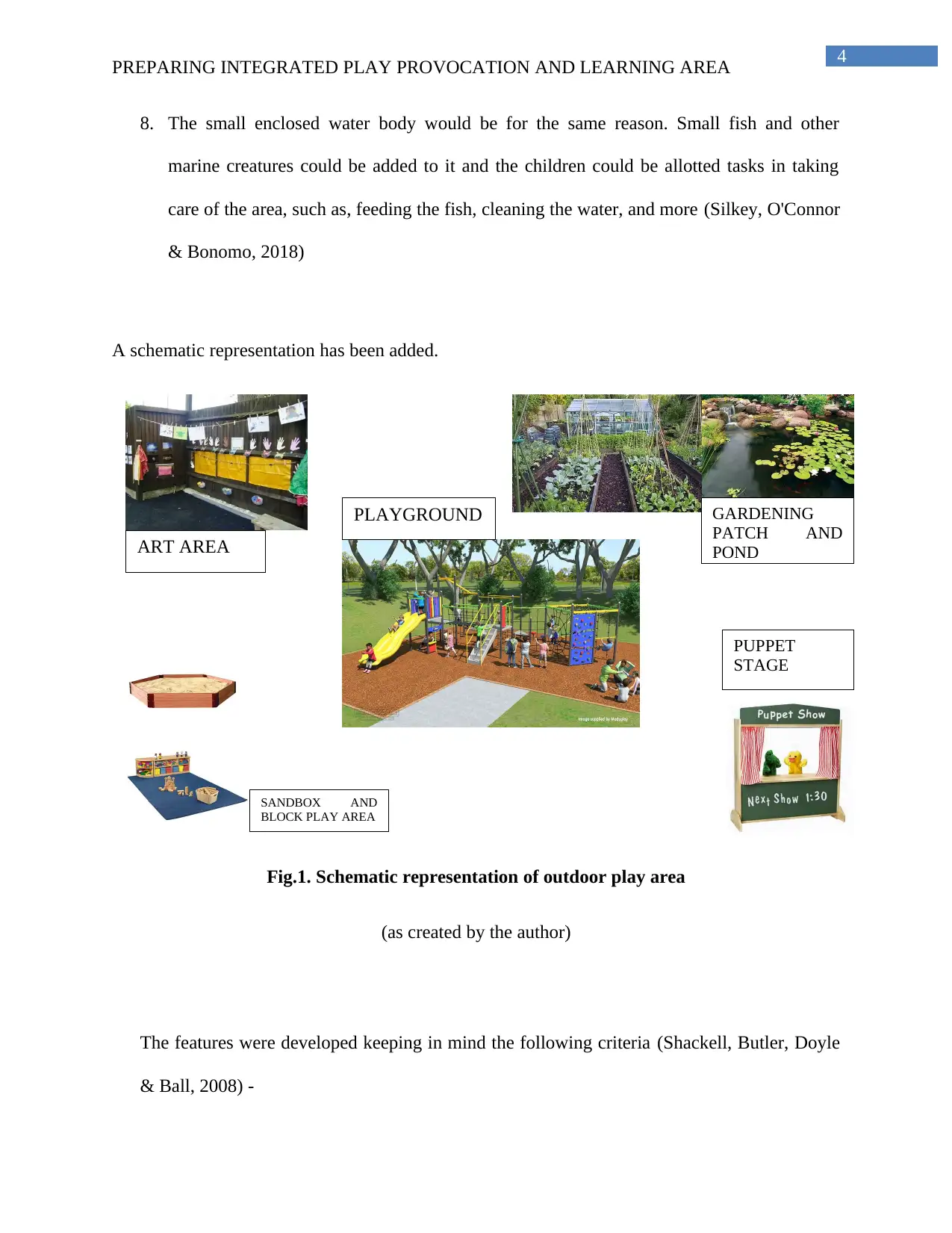
4
ART AREA
PLAYGROUND
SANDBOX AND
BLOCK PLAY AREA
GARDENING
PATCH AND
POND
PUPPET
STAGE
PREPARING INTEGRATED PLAY PROVOCATION AND LEARNING AREA
8. The small enclosed water body would be for the same reason. Small fish and other
marine creatures could be added to it and the children could be allotted tasks in taking
care of the area, such as, feeding the fish, cleaning the water, and more (Silkey, O'Connor
& Bonomo, 2018)
A schematic representation has been added.
Fig.1. Schematic representation of outdoor play area
(as created by the author)
The features were developed keeping in mind the following criteria (Shackell, Butler, Doyle
& Ball, 2008) -
ART AREA
PLAYGROUND
SANDBOX AND
BLOCK PLAY AREA
GARDENING
PATCH AND
POND
PUPPET
STAGE
PREPARING INTEGRATED PLAY PROVOCATION AND LEARNING AREA
8. The small enclosed water body would be for the same reason. Small fish and other
marine creatures could be added to it and the children could be allotted tasks in taking
care of the area, such as, feeding the fish, cleaning the water, and more (Silkey, O'Connor
& Bonomo, 2018)
A schematic representation has been added.
Fig.1. Schematic representation of outdoor play area
(as created by the author)
The features were developed keeping in mind the following criteria (Shackell, Butler, Doyle
& Ball, 2008) -
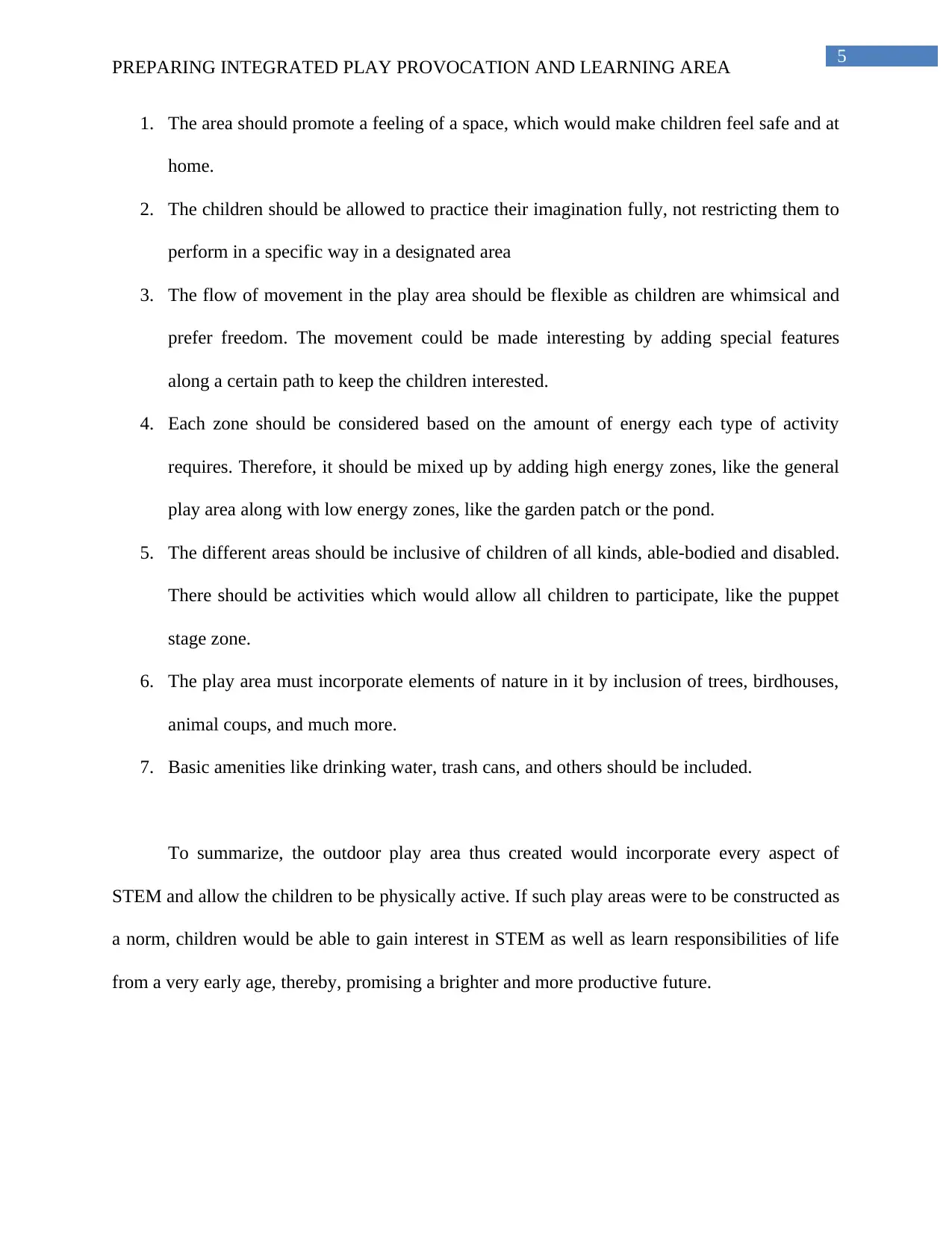
5
PREPARING INTEGRATED PLAY PROVOCATION AND LEARNING AREA
1. The area should promote a feeling of a space, which would make children feel safe and at
home.
2. The children should be allowed to practice their imagination fully, not restricting them to
perform in a specific way in a designated area
3. The flow of movement in the play area should be flexible as children are whimsical and
prefer freedom. The movement could be made interesting by adding special features
along a certain path to keep the children interested.
4. Each zone should be considered based on the amount of energy each type of activity
requires. Therefore, it should be mixed up by adding high energy zones, like the general
play area along with low energy zones, like the garden patch or the pond.
5. The different areas should be inclusive of children of all kinds, able-bodied and disabled.
There should be activities which would allow all children to participate, like the puppet
stage zone.
6. The play area must incorporate elements of nature in it by inclusion of trees, birdhouses,
animal coups, and much more.
7. Basic amenities like drinking water, trash cans, and others should be included.
To summarize, the outdoor play area thus created would incorporate every aspect of
STEM and allow the children to be physically active. If such play areas were to be constructed as
a norm, children would be able to gain interest in STEM as well as learn responsibilities of life
from a very early age, thereby, promising a brighter and more productive future.
PREPARING INTEGRATED PLAY PROVOCATION AND LEARNING AREA
1. The area should promote a feeling of a space, which would make children feel safe and at
home.
2. The children should be allowed to practice their imagination fully, not restricting them to
perform in a specific way in a designated area
3. The flow of movement in the play area should be flexible as children are whimsical and
prefer freedom. The movement could be made interesting by adding special features
along a certain path to keep the children interested.
4. Each zone should be considered based on the amount of energy each type of activity
requires. Therefore, it should be mixed up by adding high energy zones, like the general
play area along with low energy zones, like the garden patch or the pond.
5. The different areas should be inclusive of children of all kinds, able-bodied and disabled.
There should be activities which would allow all children to participate, like the puppet
stage zone.
6. The play area must incorporate elements of nature in it by inclusion of trees, birdhouses,
animal coups, and much more.
7. Basic amenities like drinking water, trash cans, and others should be included.
To summarize, the outdoor play area thus created would incorporate every aspect of
STEM and allow the children to be physically active. If such play areas were to be constructed as
a norm, children would be able to gain interest in STEM as well as learn responsibilities of life
from a very early age, thereby, promising a brighter and more productive future.
⊘ This is a preview!⊘
Do you want full access?
Subscribe today to unlock all pages.

Trusted by 1+ million students worldwide
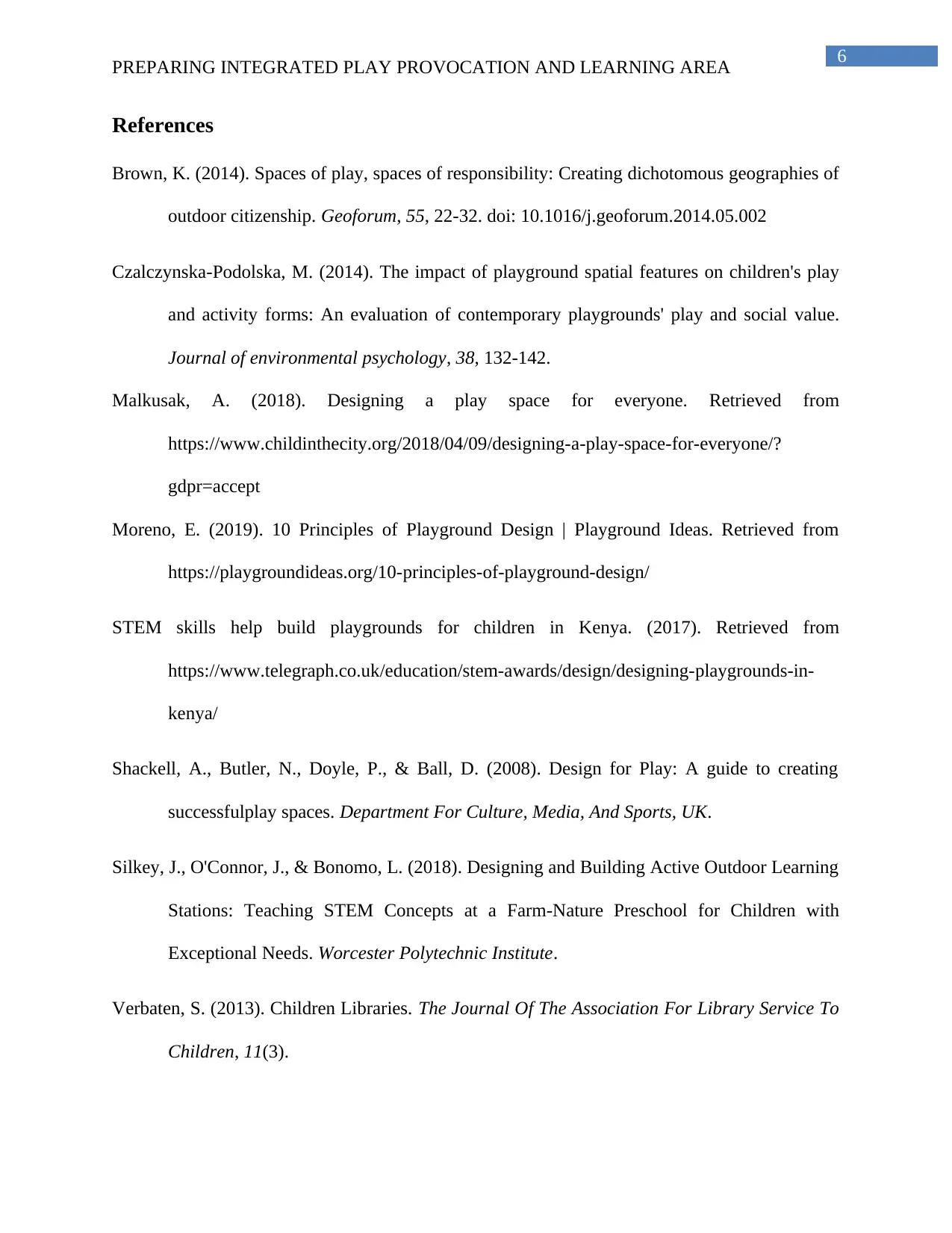
6
PREPARING INTEGRATED PLAY PROVOCATION AND LEARNING AREA
References
Brown, K. (2014). Spaces of play, spaces of responsibility: Creating dichotomous geographies of
outdoor citizenship. Geoforum, 55, 22-32. doi: 10.1016/j.geoforum.2014.05.002
Czalczynska-Podolska, M. (2014). The impact of playground spatial features on children's play
and activity forms: An evaluation of contemporary playgrounds' play and social value.
Journal of environmental psychology, 38, 132-142.
Malkusak, A. (2018). Designing a play space for everyone. Retrieved from
https://www.childinthecity.org/2018/04/09/designing-a-play-space-for-everyone/?
gdpr=accept
Moreno, E. (2019). 10 Principles of Playground Design | Playground Ideas. Retrieved from
https://playgroundideas.org/10-principles-of-playground-design/
STEM skills help build playgrounds for children in Kenya. (2017). Retrieved from
https://www.telegraph.co.uk/education/stem-awards/design/designing-playgrounds-in-
kenya/
Shackell, A., Butler, N., Doyle, P., & Ball, D. (2008). Design for Play: A guide to creating
successfulplay spaces. Department For Culture, Media, And Sports, UK.
Silkey, J., O'Connor, J., & Bonomo, L. (2018). Designing and Building Active Outdoor Learning
Stations: Teaching STEM Concepts at a Farm-Nature Preschool for Children with
Exceptional Needs. Worcester Polytechnic Institute.
Verbaten, S. (2013). Children Libraries. The Journal Of The Association For Library Service To
Children, 11(3).
PREPARING INTEGRATED PLAY PROVOCATION AND LEARNING AREA
References
Brown, K. (2014). Spaces of play, spaces of responsibility: Creating dichotomous geographies of
outdoor citizenship. Geoforum, 55, 22-32. doi: 10.1016/j.geoforum.2014.05.002
Czalczynska-Podolska, M. (2014). The impact of playground spatial features on children's play
and activity forms: An evaluation of contemporary playgrounds' play and social value.
Journal of environmental psychology, 38, 132-142.
Malkusak, A. (2018). Designing a play space for everyone. Retrieved from
https://www.childinthecity.org/2018/04/09/designing-a-play-space-for-everyone/?
gdpr=accept
Moreno, E. (2019). 10 Principles of Playground Design | Playground Ideas. Retrieved from
https://playgroundideas.org/10-principles-of-playground-design/
STEM skills help build playgrounds for children in Kenya. (2017). Retrieved from
https://www.telegraph.co.uk/education/stem-awards/design/designing-playgrounds-in-
kenya/
Shackell, A., Butler, N., Doyle, P., & Ball, D. (2008). Design for Play: A guide to creating
successfulplay spaces. Department For Culture, Media, And Sports, UK.
Silkey, J., O'Connor, J., & Bonomo, L. (2018). Designing and Building Active Outdoor Learning
Stations: Teaching STEM Concepts at a Farm-Nature Preschool for Children with
Exceptional Needs. Worcester Polytechnic Institute.
Verbaten, S. (2013). Children Libraries. The Journal Of The Association For Library Service To
Children, 11(3).
1 out of 7
Related Documents
Your All-in-One AI-Powered Toolkit for Academic Success.
+13062052269
info@desklib.com
Available 24*7 on WhatsApp / Email
![[object Object]](/_next/static/media/star-bottom.7253800d.svg)
Unlock your academic potential
Copyright © 2020–2025 A2Z Services. All Rights Reserved. Developed and managed by ZUCOL.





